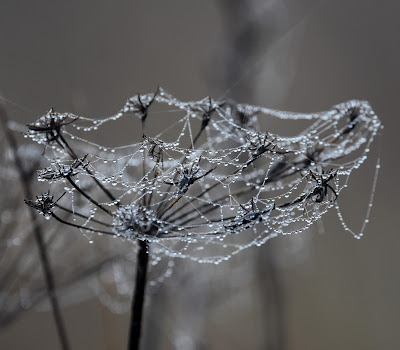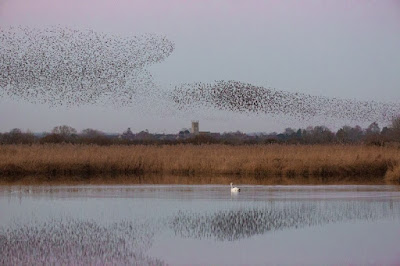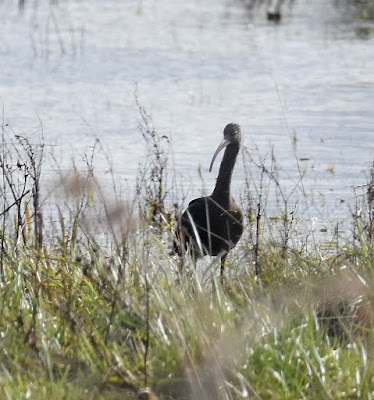January 1st Shelduck (c) JR
December has been unseasonably mild, and as I write
this the temperature outside is around 16 degrees Centigrade or sixty-one
Fahrenheit in old money! The weather may cool a little as we move into the New
Year but will still remain warmer than average. Rainfall has increased slowly,
and lying water is more noticeable across the moor, both on and off the
reserve. The reserve hydrology system relies on storing water in the reedbed
reservoirs, that can then be gradually released to keep the main grasslands
wetter for longer in a dry spring.Dew drenched cobwebs. (c) Bark
Over the past month Golden Plover and Lapwing numbers
have finally started to rise, although they are still well below the large
numbers that we expect in February and early March. Lapwings over the first screen (c) Bark
Wildfowl numbers too have
increased steadily and Wigeon flocks are scattered across the site often
grazing a short distance from open water to which they can return rapidly if
threatened. There are large numbers of Teal out on the Closes, which is wetting
up nicely.Loafing Shovellers (c) Bark
At the first screen a Jack Snipe is being seen fairly
frequently feeding amongst the Common Snipe that spend so much time on the
island with its covering of reed stubble. It is only visible when it is on the
nearest edge, and no sooner had we found it last weekend than it flew to the
other side of the spit and disappeared completely.Courting Gadwall (c) Bark
The winter finch feeding programme is now fully underway and is already attracting good numbers of birds down to the seeds. So far, we have not managed to draw in any of the Bramblings that seem widespread in the county this winter, however a Brambling was seen in Otmoor Lane on Sunday and so they are not so far away!
 |
| Linnet and Reed Bunting (c) Bark |
Chaffinches, Reed Buntings and Linnets make up the bulk of the flocks, with a scattering of Goldfinches, Bullfinches and Yellowhammers.
The Starling roost is still happening in the reedbed
at dusk, but in the depths of winter when nights are at their longest and
coldest, the birds are less likely to undertake elaborate murmuration displays.
Murmuration from the first screen (c) Tom N-L
There are still over one hundred thousand coming in to roost every night but
there is not always a coherent display, nor do they all seem to roost in the
same area. As is customary during the mid-winter holidays, the Starling roost
and murmuration is proving to be a popular early evening trip, especially for
families that have been cooped up indoors. Red Kite on patrol looking for sick or injured Starlings (c) Bark
The consequence of this popularity
is extreme congestion on Otmoor Lane, in Beckley and in the car park. As far as
possible one should car-share, arrive early and avoid key holiday dates. I
would also urge people to be patient with each other, be tolerant and kind.
Sadly, this has not always been the case this winter! I would also like to
emphasise that dogs should not be taken beyond the bridleway and out to the
reedbed. It may seem strict, but the signs are clear, and it is a very
sensitive habitat.Goldfinch on Burr (c) Bark
The Starlings and the rising numbers of Waterfowl,
Lapwings and Golden plovers are once again attracting all of the regular winter
raptors with a pair of Peregrines once again using the dead oak on Noke sides
as a watchpoint. A ring-tailed Hen Harrier is being seen daily and not always
at Starling roost time; it is frequently observed hunting them as they emerge
from the roost at dawn.Marsh Harrier Tom N-L
On the very last day of 2021 a Dotterel was found out
among the Golden Plovers on The Closes. It is almost certainly the same bird
that was seen in the company of Goldies out on Port Meadow earlier in December.
It is the first ever recorded on Otmoor and brought the year-list to an extraordinary
one hundred and sixty-nine species, a record breaker. Incidentally, the Dotterel
and the Red-breasted Geese have rendered “The Birds of Otmoor” in need of
revision!Red breasted Goose and Barnacle on Noke Sides (c) Bark
It has been a very eventful year on the moor with
exciting species being found, scarcer species breeding successfully and birds
that would once have been sought after rarities becoming more commonplace.Great White Egret (c) Bark
It
was very special to be able to see all three regular Egret species at the same
time in the same place, namely the first screen. Cattle egrets c) Bark
It has been very exciting and
challenging to have a Lesser Spotted Woodpecker an Oxfordshire rarity,
appearing from time to time this autumn, although frustrating for those of us
yet to connect with it. It was last seen on 19th December on the MOD land.
The reed stubble and islands out on the southern
lagoon have attracted a good number of autumn passage waders and still hosts a
large number of Common Snipe and at least one much more elusive but visible
Jack Snipe.Common Snipe (c) Bark
Waders were also seen during the spring passage out on the flooded
areas of Big Otmoor.
Breeding successes include at least two broods of
Garganey on both the north and south lagoons respectively, the strong
likelihood that Pintail bred again this year after breeding for the first time
in 2020. Out in the reedbed and in the smaller isolated reed stands three
separate Bittern nests were seen to raise chicks, while six Marsh Harriers were
fledged from two different nests.Garganey and ducklings
Curlew have been very successful this year nesting
beyond the reserve in the wider Otmoor basin. The weather being wet for a
longer time than usual was a significant factor, but in addition the RSPB set
electric fences up around the nests as soon as they were found, which effectively
deterred mammalian predation at the egg stage. Curlew over MOD (c) Bark
Three of the fledged Curlew were
captured and ringed, they were also fitted with flappers that were readable at
a distance. This resulted in one of “our” birds being reported from the west
coast of Ireland just days after it had left the moor.
Cranes and young shortly before they left (c) Fergus Mosey
The greatest breeding success however has to be the
Common Cranes. After six years of close calls and disappointments our “second”
pair of Cranes managed to raise a chick to the stage where it could fly. They
departed with the chick and were reported back on the Somerset Levels with the
youngster in tow several days later.
On the downside there were just two reports of Turtle
Dove, both on the same day and from two different observers, suggesting a bird
on passage.Hopefully they might be back this year (c) Bark
For so many years they have been part of the summer soundscape on
Otmoor and one of its highlights. Nationally They have been declining in
numbers and have shown little evidence in recent years of breeding success. We
have surmised that the cold and wet spring at the crucial migration time may
just have influenced them to stop heading north before they made it this far,
but that may just be wishful thinking. On a more positive note, a Nightingale
was heard singing briefly on the far side of the moor and not far from where
they last bred. Later we heard that a pair had bred successfully, not too far
away on some inaccessible MOD land near Ambrosden, perhaps they might be making
a comeback to the area.Bitterns bred again successfully (c) Nick Truby
Despite the disappointment with the Turtle Doves there
is a great deal to look forward to in the coming year and indeed in the years
to come. The RSPB has raised the necessary finance to buy the new extra piece
of land, close to Maltpit, and watching how that develops and becomes a haven
for wildlife, will be an ongoing pleasure.Glossy Ibis (c) JR
My thanks as always to the full-time staff and
volunteers for their unstinting efforts, that make and keep Otmoor the richest
and finest Nature reserve in central England.Redwing guzzling Sloes (c) Bark






















Hi! First visit to Otmoor on Sat 26 Feb; am a newbie to birdwatching but enjoyed it tremendously. Benefited from knowledgeable and friendly advice from several others present, quite possibly incl yourselves, maybe. Anyway, great blog and fantastic photos!
ReplyDeleteRe the concerns about parking, I thought I might just encourage the fact that Otmoor is readily accessible by train from London (or Oxford, etc.) It's barely two miles along the Oxfordshire Way from Islip station, and the walking with the birdwatching make for an ideal combination.
All best - Michael Lyon